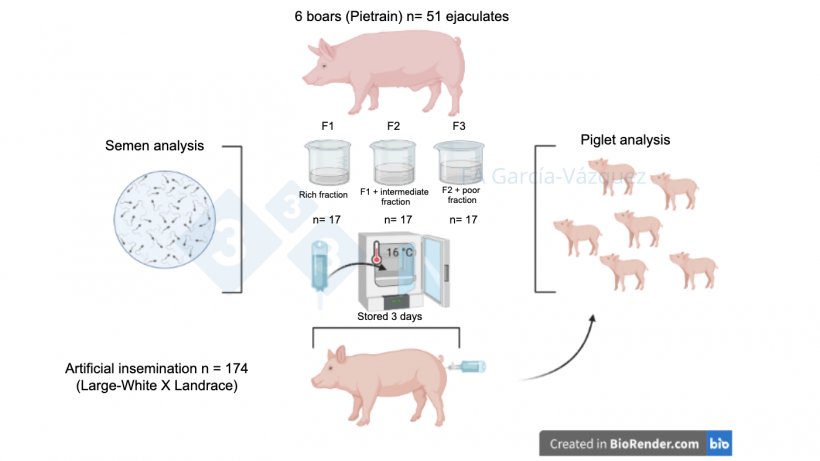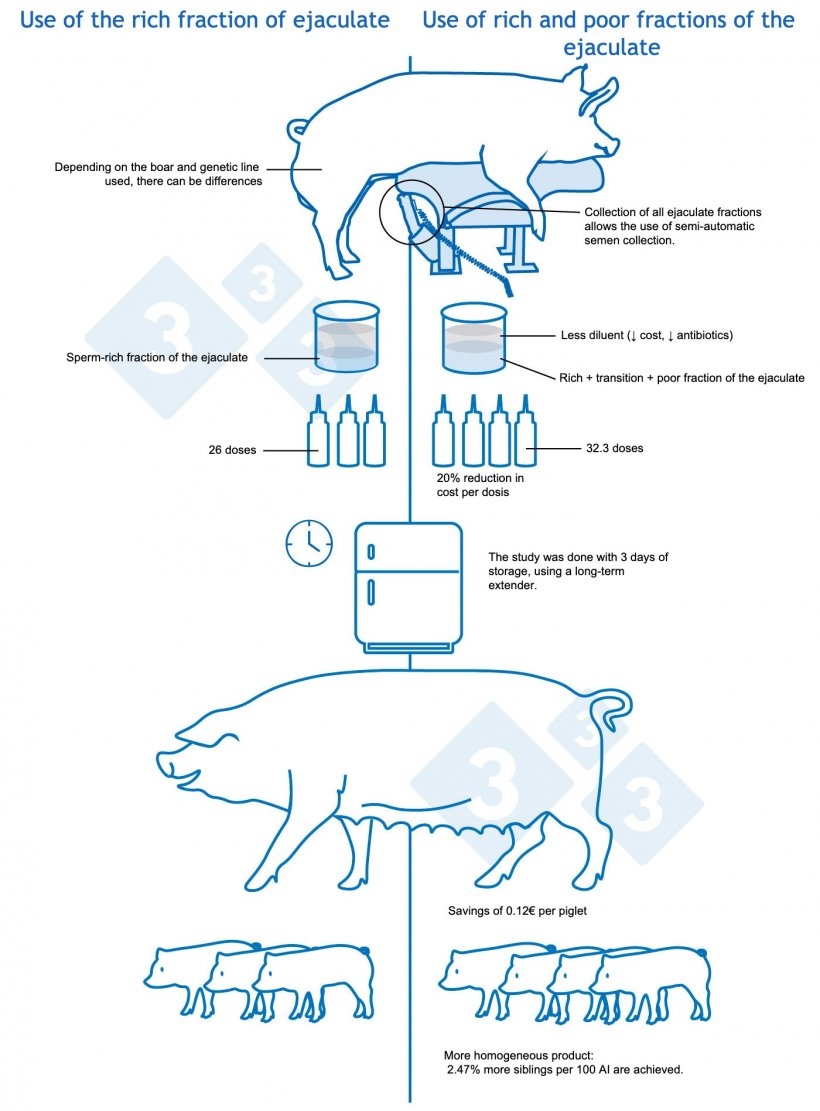Since the modern development of porcine artificial insemination (AI), one of the most frequently asked questions has been what fraction or fractions of the ejaculate should be included in the seminal doses. In general, the sperm-rich fraction of the ejaculate has been the part that has been mostly included in the doses, due to the belief that the final part of the ejaculate (post-sperm fraction characterized by high seminal plasma volume and low sperm concentration) had a deleterious effect on sperm quality during the storage of the doses. It is true that some studies have confirmed this fact, evaluating the effect of each fraction of the ejaculate separately (reviewed by Höfner et al. 2020a), but not assessing the possible synergistic effect of the different fractions as a whole on the storage of seminal doses, fertility, and offspring. To corroborate this fact, we performed a study by preparing 3 different types of seminal doses according to the fractions included during ejaculate collection: 1) Seminal dose F1: includes the sperm-rich fraction of the ejaculate; 2) F2: F1 plus the transition fraction between the rich fraction and the poor fraction; 3) F3: F2 plus the poor fraction. As usual in each collection, the initial pre-sperm fraction was discarded, as well as the gel (filtered fraction). Once the ejaculates were collected, the seminal doses were adjusted to 2000x106 spermatozoa/60 ml with commercial diluent and stored at 16ºC for 3 days. After this time, semen quality was analyzed and AIs were performed with those same doses in multiparous sows (parities 3-5). The experimental design of the study is summarized in Figure 1.
The results of the semen analysis showed that the 3 types of doses maintained a similar sperm quality, without the included ejaculate fractions affecting any parameter (video 1). While it is true that sperm quality is not always a sign of adequate fertility, AI results showed that fertility and prolificacy data were also similar between experimental groups, as well as growth and health data (assessed by hematological and biochemical analyses) in the piglets.

Figure 1. Graphical summary of the study.

Video 1. Spermatozoa motility in the different types of seminal doses (F1, F2, F3) after 3 days of being stored at 16ºC.
The results of the study indicate that the inclusion of all ejaculate fractions in the preparation of semen doses does not have an adverse effect on sperm storage or on productive performance after AI. This has a number of advantages to consider:
- Less diluent in seminal doses: the poor fraction of the ejaculate is characterized by having a high volume of seminal plasma. The inclusion of this fraction in the seminal doses leads to a reduction of the diluent to be added, since the volume is supplied by the poor fraction. In addition to reducing the cost of diluent per seminal dose, the use of antibiotics in each dose is also being reduced.
- Higher efficiency of the boars: using only the first fractions of the ejaculate in the seminal doses results in discarding part of the genetic material in the last fraction. Our study has quantified the number of seminal doses (2000x106/60 ml) as 32.3 using F3, while 26.0 were prepared with F1.
- Increased operator efficiency: collecting all ejaculate fractions means that semi-automatic semen collection can be implemented in AI centers. This results in greater efficiency in the work of the operators as they can perform several collections simultaneously.
- More homogeneous and economical final product: the use of F3 doses results in an increase in the percentage of siblings (per 100 inseminations) by 2.47% compared to the use of F1 doses. This measure contributes to an increase in the homogeneity of the product, and therefore to an improvement in precision production.
- Economic advantage: by carrying out an exhaustive economic study including fixed costs, variable costs, consumables, packaging, diluent, RO water, and PCR, a reduction in the production cost per dose of approximately 20% of F3 with respect to F1 was estimated. This cost reduction has the same impact on the production cost per piglet born alive, calculated at 0.12 € per piglet according to the study data. This reduction would be more notable in less prolific genetics.
However, although the results obtained clearly indicate the feasibility of using F3 in seminal doses, we must also take into account some possible limitations:
- Boars and genetic line: A total of 6 fertility-tested boars of the same genetic line were used and their preservation, fertility/prolificacy performance was similar between them. However, other studies have shown differences in seminal plasma composition between males and between genetic lines (Mills et al. 2020; Höfner et al. 2020b; Xu et al. 2021), so the use of other males may lead to a different efficiency in sperm preservation and reproductive performance than that obtained in the present study.
- Storage time: in our case, we compared the performance of the different types of seminal doses when stored for three days, but in certain situations, it is necessary to extend this shelf-life, so complementary studies increasing this period need to be conducted.
- Type of diluent: we have used a long term extender, but there are a multitude of diluents on the market with different characteristics and compositions, so it would be appropriate to carry out a similar study comparing the most commonly used commercial diluents.

In summary, we have demonstrated the potential use of whole ejaculate in swine production with the advantages and disadvantages described above. However, before implementing this practice in AI centers, it is recommended to carry out initial preservation tests of seminal doses with selected males, as was done in this study, in order to check sperm quality and optimize male performance.
Project funded by the Spanish Ministry of Science and Innovation (PID2019-106380RBI00 MCIN/AEI/10.13039/501100011033










